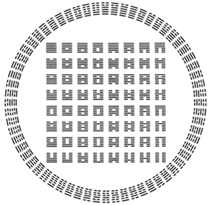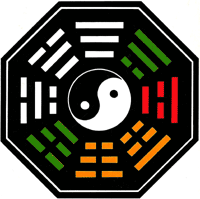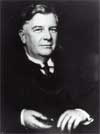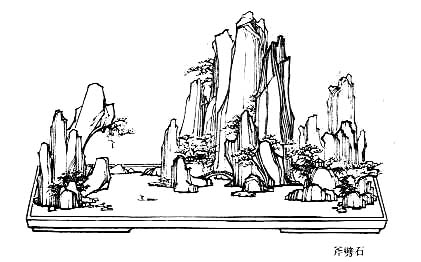Yi Jing  – I Ching, the Book of Changes
– I Ching, the Book of Changes
This famous system of 64 hexagrams plus their commentaries and transformations is at the root of Chinese thought. Tr. Wilhelm (en, fr).
| 01¬02 03×04 05×06 07×08 09-10 11×12 13×14 15-16 17-18 19-20 21-22 23-24 25-26 27¬28 29¬30 31-32 33-34 35×36 37-38 39-40 41-42 43-44 45-46 47-48 49-50 51-52 53-54 55-56 57-58 59-60 61¬62 63¬64 |
Introduction

Extracts from the Wilhelm's I-Ching translation's introductory : « The Book of Changes – I Ching in Chinese – is unquestionably one of the most important books in the world's literature. Its origin goes back to mythical antiquity, and it has occupied the attention of the most eminent scholars of China down to the present day [i. e. around 1920]. Nearly all that is greatest and most significant in the three thousand years of Chinese cultural history has either taken its inspiration from this book, or has exerted an influence on the interpretation of its text. Therefore it may safely be said that the seasoned wisdom of thousands of years has gone into the making of the I Ching. Small wonder then that both of the two branches of Chinese philosophy, Confucianism and Taoism, have their common roots here. [...] »
« In the course of time, owing to the great repute for wisdom attaching to the Book of Changes, a large body of occult doctrines extraneous to it – some of them possibly not even Chinese in origin – have come to be connected with its teachings. The Ch'in and Han dynasties saw the beginning of a formalistic natural philosophy that sought to embrace the entire world of thought in a system of number symbols. Combining a rigorously consistent, dualistic yin-yang doctrine with the doctrine of the "five stages of change" taken from the Book of History, it forced Chinese philosophical thinking more and more into a rigid formalization. Thus increasingly hairsplitting cabalistic speculations came to envelop the Book of Changes in a cloud of mystery, and by forcing everything of the past and of the future into this system of numbers, created for the I Ching the reputation of being a book of unfathomable profundity. [...] »
« At the outset, the Book of Changes was a collection of linear signs to be used as oracles. In antiquity, oracles were everywhere in use; the oldest among them confined themselves to the answers yes and no. This type of oracular pronouncement is likewise the basis of the Book of Changes. “Yes” was indicated by a simple unbroken line  , and “No” by a broken line
, and “No” by a broken line  . However, the need for greater differentiation seems to have been felt at an early date, and the single lines were combined in pairs.
To each of these combinations a third line was then added. In this way the eight trigrams came into being. »
. However, the need for greater differentiation seems to have been felt at an early date, and the single lines were combined in pairs.
To each of these combinations a third line was then added. In this way the eight trigrams came into being. »
 « These eight trigrams were conceived as images of all that happens in heaven and on earth. At the same time, they were held to he in a state of continual transition, one changing into another, just as transition from one phenomenon to another is continually taking place in the physical world. Here we have the fundamental concept of the Book of Changes. The eight trigrams are symbols standing for changing transitional states; they are images that are constantly undergoing change. Attention centers not on things in their state of being – as is chiefly the case in the Occident – but upon their movements in change. The eight trigrams therefore are not representations of things as such but of their tendencies in movement. »
« These eight trigrams were conceived as images of all that happens in heaven and on earth. At the same time, they were held to he in a state of continual transition, one changing into another, just as transition from one phenomenon to another is continually taking place in the physical world. Here we have the fundamental concept of the Book of Changes. The eight trigrams are symbols standing for changing transitional states; they are images that are constantly undergoing change. Attention centers not on things in their state of being – as is chiefly the case in the Occident – but upon their movements in change. The eight trigrams therefore are not representations of things as such but of their tendencies in movement. »
« These eight images came to have manifold meanings. They represented certain processes in nature corresponding with their inherent character. Further, they represented a family consisting of father, mother, three sons, and three daughters, not in the mythological sense in which the Greek gods peopled Olympus, but in what might be called an abstract sense, that is, they represented not objective entities but functions. »
Translation
 The definitive English translation; from Chinese into German by Wilhelm, into English by Baynes. Wilhelm was in prolonged contact with the oral tradition at the very end of the Imperial era, via his teacher Lao Nai-hsuan. He was the right man in the right place at the right time; this is not something that can be re-done, no matter how good fresh translations are. As Carl Jung put it, it is as if this book “delivered the last message of the old, dying China to Europe”.
The definitive English translation; from Chinese into German by Wilhelm, into English by Baynes. Wilhelm was in prolonged contact with the oral tradition at the very end of the Imperial era, via his teacher Lao Nai-hsuan. He was the right man in the right place at the right time; this is not something that can be re-done, no matter how good fresh translations are. As Carl Jung put it, it is as if this book “delivered the last message of the old, dying China to Europe”.
 The quality of the language used is superb, it rates as a work of literature. Although beginners often feel that Wilhelm is too complicated and seek a simpler version to start with, what I would recommend is that they get Wilhelm as early as they can and just use Book I initially, ignoring Book II (The Great Treatise) and Book III (Commentaries) until they feel more confident to tackle them. Only Wilhelm has the necessary depth for a reliable interpretation. While it is true there are a few passages in need of revision, these are far fewer than in any other translation, and in general Wilhelm manages to convey the essential meaning via his summaries of the Neo-Confucian commentary material, which is without equal in any other version. » Cf. this page about I-Ching translations.
The quality of the language used is superb, it rates as a work of literature. Although beginners often feel that Wilhelm is too complicated and seek a simpler version to start with, what I would recommend is that they get Wilhelm as early as they can and just use Book I initially, ignoring Book II (The Great Treatise) and Book III (Commentaries) until they feel more confident to tackle them. Only Wilhelm has the necessary depth for a reliable interpretation. While it is true there are a few passages in need of revision, these are far fewer than in any other translation, and in general Wilhelm manages to convey the essential meaning via his summaries of the Neo-Confucian commentary material, which is without equal in any other version. » Cf. this page about I-Ching translations.
Confer
- Original text in traditional Chinese characters found in Chinapage.com.
- Richard Wilhelm's translation, rendered into English by Cary F. Baynes, found here.
- La traduction en français est une adaptation due à Étienne Perrot de la traduction allemande du Père Richard Wilhelm.
- 1885, French, par Paul-Louis-Félix Philastre (1837-1902), dans Les Cinq Livres canoniques ou Grands Kings. Editions Zulma, 1966, 890 pages. Première édition, Ernest LEROUX, Paris, 1885. Disponible en ligne dans la Collection Chine ancienne réalisée par Pierre Palpant.
- 1899, English, by James Legge, in The sacred Books of China, Vol. XVI, Clarendon Press.
- 1965, English, Blofeld. The Book of Changes: A New Translation of the Ancient Chinese I Ching. New York, E. P. Dutton.
- 1998, English, Huang. The Complete I Ching: the Definitive Translation From the Taoist Master Alfred Huang, Rochester, N.Y, Inner Traditions.
- 2001, French. Cyrille J.-D. Javary et Pierre Faure, Yi Jing. Le Livre des Changements, Paris : Albin Michel, février 2002. Voir aussi Cyrille Javary, Les Rouages du Yi Jing, 2001, ed. Philippe Picquier.
- Wikipedia : I Ching (en), (fr).
- Dmoz : I Ching (en).
L'eau est au-dessus du feu :
Image de la ...
Si l'eau déborde, le feu s'éteint et sou énergie est perdue"
contains a typo. Should be "...et son énergie...".
Bye

I Ching, the Book of Changes – Yi Jing – Chinese off/on – Français/English
Alias Yijing, I Ching, Yi King, I Ging, Zhou yi, The Classic of Changes (Lynn), The Elemental Changes (Nylan), Le Livre des Changements (Javary), Das Buch der Wandlung.
The Book of Odes, The Analects, Great Learning, Doctrine of the Mean, Three-characters book, The Book of Changes, The Way and its Power, 300 Tang Poems, The Art of War, Thirty-Six Strategies
Welcome, help, notes, introduction, table.
Index – Contact – Top








